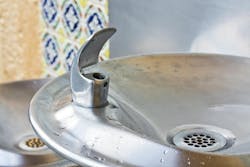New Hampshire reports on lead in drinking water at schools, childcare facilities
The New Hampshire Department of Environmental Services (NHDES) has released a report on the first three rounds of lead testing in drinking water at New Hampshire’s K-12 schools and licensed childcare facilities.
The report, titled “New Hampshire Lead in School and Child Care Drinking Water Findings from Round 1 of Testing and Remediation (2016 – 2023),” provides a summary of the sampling results since a 2018 law required the testing.
This is the first of three data briefs to be issued once the additional sampling rounds are completed.
Facilities that have not started their Round 2 sampling must do so as soon as possible to make the deadline for completing the required 3 rounds of sampling by June 30, 2024.
The most up-to-date test results and remediation information are available on the NHDES View Results page.
Under New Hampshire’s Get The Lead Out of Drinking Water program, all K-12 schools and licensed child care facilities must test all drinking water outlets available for consumption by children, including drinking fountains, classroom sinks and kitchen sinks. A revision to the state law in July 2022 lowered the action level for this program from 15 parts per billion (ppb) to 5 ppb, and changed the timing of the testing such that three rounds must be completed by June 30, 2024.
During the first round of testing, sample results from over 23,000 drinking water outlets from 625 schools and 594 licensed childcare facilities were processed. Results show that one out of five child are facilities and three out of five schools had at least one drinking water outlet that tested at or above the 5 ppb action level. Overall, 14% of all water outlets sampled had a result at or above the 5 ppb action level, 25% had a result between 1 and 5 ppb and 61% showed no lead detected.
Facilities must remediate, eliminate or reduce lead levels at all drinking water outlets that test at or above 5 ppb. Remediation information was collected for 92% of drinking water outlets that require remediation. The most common methods of remediation were permanently removing the water outlet from service or posting no drinking/handwash only signage (51%) and replacing the outlet with a new fixture (16%).
Funding for the Get the Lead Out of Drinking Water Program is provided by the U.S. Environmental Protection Agency (EPA) Water Infrastructure Improvements for the Nation (WIIN) Act and includes free testing for all childcare facilities and public schools.
In addition, the New Hampshire Drinking Water and Groundwater Trust Fund has awarded $1.6 million for remediation grants for public and private schools, and is working with NH Department of Health and Human Services to establish a grant program for childcare facilities. Information about the remediation grant will be available this fall and will be posted on the Get the Lead Out webpage.
